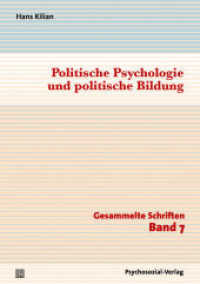Full Description
How do you develop students' capacities as independent learners, build their confidence and motivation to identify their own research agendas, and facilitate their critical thinking and research skills for effectively exploring their chosen topic? Inquiry-based learning (IBL) offers a proven means to achieve these outcomes.IBL is a scaffolded learner-centered, student-led approach to inquiry whereby students progressively design and lead their own inquiry process, with support from the instructor. It's a powerful pedagogical approach that you can progressively adopt, first adopting it as an activity in a course to develop you and your students' comfort with the practice, right up to developing an entire course or program utilizing IBL. It offers varying levels of engagement as you and your students gain familiarity with the practice, from the instructor providing structured support, to formative guidance as students gain confidence, to a point where students become increasingly self-directed and independent and are supported by the review of student peers and validated by presentations of their work to the class. This pedagogy shifts the student/instructor relationship, with the former leading and the latter supporting. IBL is a flexible teaching and learning approach that be can progressively adopted and developed without a specific formula, and that positions students as co-constructors of knowledge, rather than passive recipients. It is student-driven, creates engagement, develops a curiosity mindset, promotes group learning that is collaborative rather than competitive, fosters metacognition, and builds confidence as students learn to deal with ambiguity and risk.Each chapter offers personal stories, vignettes, examples of practice, and discussions of issues.This book offers higher education instructors at any career stage and in any discipline, a realistic guide to incorporating curiosity and inquiry-based learning into their classrooms to promote long term knowledge creation and retention and life-wide learning.IBL is being increasingly adopted across the English-speaking world. Beyond its inherent capacity to promote independent learning, it offers a perfect foundation for preparing students for Signature Work and capstone courses; and is adaptable to small and large classes.
Contents
Foreword—Alastair Summerlee Acknowledgments Introduction Part I. The Fundamental Principles of IBL and Adopting a Curiosity Mindset 1. The Fundamental Principles of Inquiry-Based Learning 2. Developing a Curiosity-Based Mindset and Reimagining the Roles of Instructor and Student in IBL-HE Part II. How Do I Determine Where to Start with My IBL-HE Practice? 3. Should I Start from Scratch or Adapt What I Already Have? 4. How Much IBL and How Much Structure Should I Include When Getting Started? 5. What Are My Options for Assessing Learning in IBL-HE? Part III. How Do I Get My Students Started with IBL-HE? 6. How Do I Encourage Students to Participate and Ask Good Questions? 7. How Do My Students and I Choose Research Methods in IBL-HE? 8. I Know Reflection is Important but What Do I Ask Students to Reflect On? 9. What Kind of Feedback Do Students Need From Me and Each Other? Part IV. How Do We Build the Supportive Relationships that Allow IBL-HE to Thrive? 10. How Do I Create a Trusting Classroom Environment that Supports Interdependent Learning? 11. How Can I Incorporate the Community in MY IBL-HE Practice? 12. How Do I Find Mentoring and Build a Community of Practice? 13. What Kind of Institutional Support Do I Need to be Successful at IBL-HE? Part V. What Does Successful IBL-HE Look Like in the End? 14. Student Engagement and Pride in Learning 15. Adopting a Lifelong and Life-Wide Learning Mindset and Using Your Inquiry Skills Beyond the Classroom 16. Academic and Personal Transformation 17. Increased Social Justice Focus In and Out of the IBL-HE Classroom Conclusion. The End of This Book is Just the Beginning Appendix A. Structured Controversy Appendix B. The Curiosity Project Appendix C. First Year Inquiry Studies Appendix D. IBL in Block Week and Group Study Appendix E. Additional Resources References About the Authors Index








